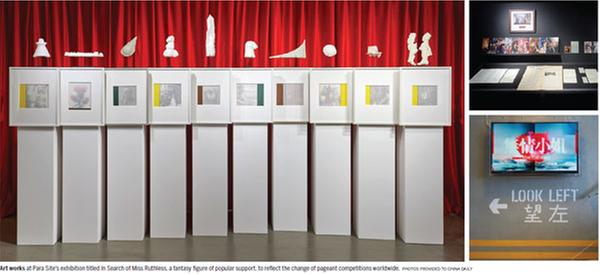The beauty of being both

Para Site's current art exhibition plays up the excesses and empowering aspects in a beauty pageant, telling us that they may not be mutually exclusive. A review by Chitralekha Basu.
What do the syncopated strikes made with rubber sandals on a tiled platform at the harbor front in Whampoa and the feminine beauty ideal have in common? What are two people of ambiguous sexual identity doing in a video, tying themselves at either ends of a silicone barbell and then trying to tear apart from each other? How's a strawberry pink heart-shaped platform related to a minimal wooden frame suggesting the outline of an office cubicle? And how on earth is one supposed to figure that a flimsy papier-mache sculpture which looks like an obtuse triangle with the hypotenuse curving inwards supposedly represents Princess Diana of Britain?
And what's all of the above got to do with beauty queens and their made-up lives on and off stage, which is what Para Site's current exhibition, In Search of Miss Ruthless, is apparently about?
Curators Hera Chan and David Xu Borgonjon took their cue from the Chinese-American cultural critic Rey Chow's notion of the sentimentality that's supposedly inherent in Chinese culture. The idea is to see sentimentality as "not just a sign of weakness, which is how it's often interpreted as, but as a kind of endurance, resilience and power", says Xu. In other words, sentimentality is interpreted as a set of emotions manifest in extreme determination as well as extreme vulnerability.
It had seemed to the curators that the murky world of beauty pageants could serve as an ideal apparatus to explore these apparently conflicting emotions which often end up feeding each other. Marked as it is by meanness, manipulation and often an unhealthy rivalry between contestants, beauty contests could also, potentially, belong in a space where genuine feelings surface and true friendships are forged. The backstage intrigues in the lead-up to the crowning and the on-stage drama during the show and its immediate aftermath could be both demeaning and empowering to the contestants, often at the same time.
"Sentimentality and ruthlessness are not opposites. They actually co-exist in a pageant," says Xu. "Being in a beauty pageant requires a degree of ruthlessness. You have to be very focused and competitive."
And then it struck the curators that for a large section of people living in Hong Kong, coping with life in the city also required a degree of ruthlessness. "Here ruthlessness forms the basis of conventionally sentimental social relations," says Xu.
And that's where Fiona Lee's sound-based performance-art show, performed at Whampoa, comes in. Lee discovered that the movement of the tides underneath the perforated paved viewing deck at Whampoa created a range of tonalities which could in fact be made to harmonize, depending on the timing and pacing of the strikes.
Xu says the slightly odd but deep and varied sounds created by the strike of rubber sandals on the stone platform jutting out into the sea, or by the flutter of plastic bags attached to the holes drilled into the ground, could in fact be read as a commentary on reclaiming land from the water and dressing it up.
"One of our themes was the changing face of the city - the urban beautification project. Hong Kong has been dramatically transformed by people with different ideas about what constitutes a beautiful city. Fiona's performance makes people think about changing coastlines and creation of views."
De-familiarizing the familiar
In Search of Miss Ruthless is about looking at beauty contests and, by extension, the place of women - as well as transgenders, gender fluids, men, the whole human race really - in a normative society from an angle, or several angles, at the same time.
For instance, at first glance, Ma Quisha's three-channel video film, Avatar, looks like three women sunning themselves on a beach. The accoutrements - sunglasses, bikinis, flip-flops - match one's expectations of such a scenario until an element of strangeness is introduced in the form of copies of the Holy Bible and prayer beads. Moments later the camera pulls back, revealing that the women were in fact sprawled out on a truck filled with sand.
Tse Ka-man's photograph, Embrace, spoofs the rehearsed exaggerated gestures that beauty contestants are known to display immediately after the crowning. The fellow participants swarming around the newly crowned beauty queen seem to morph into a hydra-headed mass with multiple limbs. It could be a moment of "Cathartic release" for contestants who spent months and years preparing for it, as curator Xu points out. On the other hand, the melodramatic show of being overcome with emotion could be seen as a part of an act - a final ritual in a series of many such.

New York-based Hong Kong-born artist Christopher K Ho's installation series, I Personally Believe, features 10 light-weight sculptures made out of paper pulp, which could be mistaken for a child's handiwork. These are mounted on pedestals against a plush red curtain, as if they were finalists in a beauty pageant, facing the jury.
The title of the series, says Ho, is borrowed from a certain Miss South Carolina's response to a question during the 2007 Miss Teen USA pageant. "Her extraordinarily convoluted and botched response, which began 'I personally believe,' became an instant internet phenomenon, replayed ad infinitum," says Ho. The tautological phrasing had made Ho wonder if "the repetition of actions, gestures and platitudes in beauty pageants capture common culture, and even telegraph shared ideals? Might the pageant queen's stiff wave - or even the canned parts of Miss South Carolina's response - be an embodied form of cultural memory, too?"
Ho has challenged the hype over what is recognized as beauteous and grand in popular imagination. Princess Diana, widely regarded as an ideal of feminine beauty, is represented by a 3D print of her long, rumpled wedding train. The sculpture is so tiny and flimsy compared to the voluminous bulk of the original that it's difficult to even make a connection with Princess Diana's spectacular wedding ceremony which had caught the imagination of the world.
Ho has pulped pages from Strathmore paper sketch books, combining old and new, experimental technologies to create the sculptures. "I made molds by CNC routing plaster blocks (rather than taking the traditional route of making positives and then producing molds from those). I also used paper, which shrinks when dried, so the details were inevitably lost," says Ho, explaining his process. The paring down of something that was extravagant and relentlessly flogged by the media to just a hint of the original, says the artist, was done as a nod to the principles of modernism, which often discards the extraneous.
But then the route to such minimalist representations, he adds, "could be paradoxically achieved through embracing, rather than narrowing down, possibilities; through showcasing multiple solutions rather than one solution".
Ho's comment sounds like a succinct observation of the In Search of Miss Ruthless show. By turning the audience's gaze toward both the excesses and the empowering features in beauty pageants, by taking a long hard look at the made-up and the real, the curators have brought the many truths about the beauty industry into focus.

(HK Edition 09/08/2017 page10)
Today's Top News
- China remembers victims of Nanjing Massacre 88 years on
- Philippines' provocations will avail it nothing: China Daily editorial
- China steps up financial support to spur consumption
- China marks milestone in developing complex deepwater oil and gas reservoirs
- China remembers victims of Nanjing Massacre, 88 years on
- New plan will be a road map for a stronger future






























